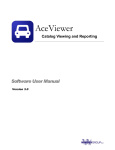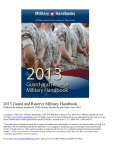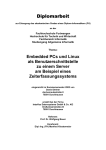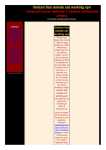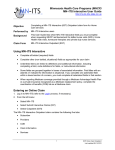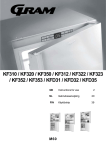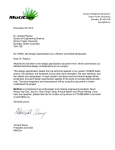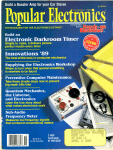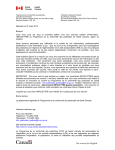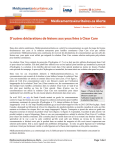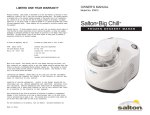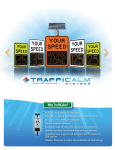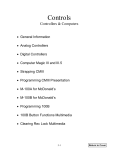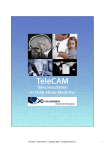Download safety meeting
Transcript
Volume 11 Number 5 April 2014 L e a d S t o r y Do it yourself and think safety Every homeowner encounters the opportunity to take on a do-it-yourself project at one time or another. It’s gratifying to see a project come to fruition and know that you’ve had a hand in its success. However, the importance of safety and health often gets forgotten in a doit-yourself (DIY) plan. Home improvement incidents send thousands of people to the ER each year. A recent article in Consumer Reports listed the top injuries that occur to homeowners doing home repairs, remodeling, yard work and other projects. Citing statistics from the Home Safety Council, the magazine reported that one in five consumers will likely need medical attention. The leading causes of injury were: Falling off ladders, getting struck by mower debris, lacerations from a power tool or chain saw, and burns or breathing difficulties caused by household chemicals. DIY projects also open up a can of worms when it comes to health hazards. First there is the dust from sanding, drywall, insulation and plaster – which can irritate the airways of people with lung conditions such as asthma. Flooring, too, raises health issues. House paints also contain volatile organic compounds (VOCs), organic chemicals that are emitted as gases and cause fatigue, headaches, nausea and skin and lung irritation. As well, paint thinners, strippers and varnishes all contain solvents that can lead to lung and skin irritation, headaches and dizziness. According to a recent article from Global News, a recent U.S. Center for Stay safe. Stay healthy. Stay current. Inside this month’s issue of Comfort Zone: (Click on the page numbers to go directly to the section.) Making Headlines Pages 2-3 n Volunteer for your health n New refrigerant regulations n Dental care tips for kids n Learn to drive eco-friendly Working Safely Pages 4-5 Disease Control report focused on a case in Quebec where 14 people fell ill with a pneumonia-like infection after the exterior brick of a centuryold house was removed as part of a renovation. Workers, residents of the home and neighbors have recovered after developing symptoms of a fungal disease called histoplasmosis, which is carried in the droppings of bats and birds. Cases of histoplasmosis infection are rare in Canada and usually involve construction work that stirs up clouds of dried-up aerosolized spores that people end up inhaling. In the Quebec case, workers had been given masks to wear but didn’t do so continuously due to hot weather. This extreme case is just one scenario that can happen when you decide to take on a home renovation project. It demonstrates the importance of being prepared for any possible situation the same way that you should keep safety in mind when you are at work. Whether you are embarking on a Please turn to page 3 n n n n Recycling electronics Haste hurts lives Poisonous plant safety Consumer product recalls Health & Safety Round up Page 6 n I Learned The Hard Way contest entry - Hotel Fire n Websites support chronic disease sufferers Your Healthy Lifestyle Pages 7-8 n A lesson in “healthwashing” n Combat pet fleas and ticks n Tips on buying a new vehicle n Intimacy and cancer n Pool safety tips Safety Meeting Pages 9-11 Power tool safety www.skilven.com page 2 M a k i n g H e a d l i n e s Senior volunteers get unexpected health benefits (NC) More than 1.8 million Canadian senior citizens volunteer because they want to give back and make an impact in their communities. Researchers have found that these seniors are getting much more than they expected: improved health as compared to those seniors who don't volunteer. “When retirees give their time to others, their social networks and support systems increase and there’s also an increase in their happiness, energy and vitality,” says Dr. Ben Gottlieb, a University of Guelph psychology professor who has been researching the positive health benefits of volunteering among seniors. “They experience better cardiovascular function, less arthritis pain, better lung function, lower stress, anxiety and depression and have an overall increase in selfesteem and sense of value.” Leona Darling, 75, has been volunteering for the past 23 years. Her volunteer career started when she responded to an ad in the paper looking for Hospice volunteers and she has been with the organization ever since. “When I started volunteering, I owned a business that required me to use a very specific set of skills so I sought opportunities that would allow me to learn new skills or maintain skills I wasn't using in my job,” she explains from her home in Guelph, Ontario. “For the past 16 years, I have been providing one-toone grief support for individuals who have requested help from Hospice after they have lost a loved one. By listening to my clients, they have a safe, confidential place to voice their concerns. I feel what I do matters and get a lot of personal satisfaction out of it. I’ve actually been told I was a life saver and there is no greater compliment.” Since retiring, Darling has taken on a second volunteer job with Chalmers Community Service Centre where she has seen the health benefits of volunteering in her peers. “We have a number of 80-year-old volunteers who are keeping young and active because they are out there giving back instead of sitting at home. Many people don't believe they're 80 because of their physical ability and sharp brains,” she said. A 2005 study found that seniors who volunteered at least two hours per week (100 hours annually) showed slower declines in selfreported health and physical functioning, and lower mortality rates than those who did not volunteer. In 2010, Canadian seniors collectively volunteered more than 372 million hours, according to Statistics Canada. Many of them say they heard about volunteer opportunities through family, friends, volunteer centres and online at; volunteer.ca. Refrigerants, new regulations, and what you need to know (NC) You may have heard that Canada is phasing out ozone-depleting refrigerants including R-22 (HCFC-22), which is found in the majority of heat pumps and air-conditioning units. You may also wonder what this means for you. Does your system have R-22? Do you have to replace the refrigerant? Will you need to buy a whole new piece of equipment? In fact, each one of these options should be considered and as an equipment owner, you need to find out which option is best for your system. Unless your system has been installed in the last few years, it most likely contains R-22. With R-22 refrigerant being phased out over the next 7 years, there will be less R-22 available for service and it is becoming more expensive. Though you can continue to use R-22 for the foreseeable future, you should also look at the options of replacing the type of refrigerant in your current system or replacing the system itself with one that uses a non-ozonedepleting refrigerant. Another factor you need to consider is that Canadian regulations do not permit new systems containing R22 to be manufactured or imported into Canada. There are alternative non-ozonedepleting ‘drop-in’ refrigerants available that can replace the R-22 in your system with a small number of changes to the equipment. If you determine that the system should be replaced, pick a system that uses a newer non-ozonedepleting refrigerant. The most popular refrigerant offered by manufacturers is R410A. Remember to ensure that all system components are changed when you move to the new refrigerant. The best way to make sound decisions about your air conditioning or heat pump system is discuss your options with a qualified heating and air conditioning contractor, and to have the contractor properly maintain your heating and cooling systems through annual maintenance checks. For more consumer tips and information,visit; www.hrai.ca/educationcentre.html The information presented in Comfort Zone has been compiled from sources believed to be reliable. However, it cannot be assumed that all acceptable measures are contained in this article nor that additional measures may not be required under particular or exceptional circumstances, or your own company procedures, or by federal, state/provincial and local law. Local, state/provincial and federal regulations take precedence over this material. We reserve the right to make periodic changes, additions, and deletions to these publications, and the products and programs described in these publications without notice. Comfort Zone is published monthly by Skilven Publications Ltd. www.skilven.com. All rights reserved. © 2014. No part of this publication is to be copied without permission from the publisher with exception to the safety meeting contained herein. President & CEO: Chris Skilton Sales: Art Hamilton • Alan Haycroft • Liz Slobodin • Carol Wilkinson Kevin Harvey • Champagne Choquer Editor: Kate Van Hoof - Peeren Contributing Writer: Bryden Winsby TOLL FREE: 1-888-655-4800 • Fax: 1-250-487-2104 Mailing Address: 101-196 Wade Ave W Penticton, British Columbia V2A 1T6 www.skilven.com • [email protected] page 3 www.skilven.com M a k i n g H e a d l i n e s Do it yourself and think safety Continued from page 1 do-it-yourself project or enlisting a professional, always make health and safety a top priority throughout the home renovation process. No project is worth risking serious injury. Here are some basic safety tips every homeowner should consider before rolling out the tool chest. 1. Dress with your safety in mind. Fortunately, serious injuries can be easily prevented with simple precautions. If you have long hair, tie it back. Remove jewelry and loose clothing that could get caught in machinery. 2. Wear a dust mask, respirator and safety goggles. Understand the materials you're working with and protect against inhaling dust particles or fumes. Similarly, safety goggles reduce the likelihood of sustaining injury to the eyes. 3. When working with electricity, wear rubber-soled shoes. Rubber acts as an insulator and reduces conductivity of electricity and your chances of electrocution. However, in most cases, electrical repairs should be left to professionals. 4. Keep any machinery and equipment in top shape. Drill bits, cutters, and other blades that are left to dull can cause injuries. Dull blades can bind or kickback. Keep your blades sharp and up-todate. 5. Use ladders safely. For every four feet of height, your ladder should sit at least one foot from the vertical surface upon which it is leaning. Know the height of your ladder and situate it accordingly. Never step on the top two rungs of a ladder. 6. Get professional help with certain materials. If you come across a substance you suspect is dangerous, such as asbestos or mold, call in a team with expertise in removing dangerous substances. Teach kids how to take care of their teeth (NC)— Good oral health is essential to total health and wellbeing at any age. Help your children to develop daily oral hygiene habits that will give them something to smile about. Here are some helpful tips: Children ages 3–6: Help your little ones to brush their teeth twice a day, using a pea-sized amount of fluoride toothpaste. Show them how to brush every tooth surface and their tongue, and make sure that they spit out the toothpaste when they are done. Children ages 6-13: Encourage them to begin flossing once a day, in addition to brushing twice a day for two minutes with fluoride toothpaste. Help children to make healthy food choices, avoiding sweets and sugars. Have them fitted for a sports mouthguard to be worn during athletic activity. Teenagers: Remind them to brush their teeth at least twice a day with fluoride toothpaste, rinse with an antibacterial mouthwash, and clean in between the teeth at least once a day. Help your teenager to eliminate tobacco use and eat nutritious foods that are low in sugar. Teens should also remember to wear a sports mouthguard during active play. More information about oral care is available online at www.dentalhygienecanada.ca. Drive eco-friendly (NC) Here are a few tips to drive with safety and economy in mind: n Accelerate gently. The harder you accelerate the more fuel you consume. In the city, you can conserve fuel by easing onto the accelerator pedal gently and gradually. Pretend there's an egg under the gas pedal and an open cup of coffee on the dash. Try to drive without breaking the shell or spilling the coffee and you'll be good to go. n Maintain a steady speed. Be consistent. Unintentional dips in speed and sudden bursts of acceleration take a toll on your tank and your wallet. In fact, tests show that varying your speed up and down between 75 km/h and 85km/h every 18 seconds can increase your fuel use by 20 percent. Use cruise control whenever possible (not when driving in winter conditions). n Anticipate traffic. Read the road ahead, anticipate road disruptions, monitor the movements of pedestrians and other vehicles and keep a comfortable distance between your vehicle and the one in front of you. n Coast to decelerate. Coasting to a stop with your foot off the pedal is like driving for free. By anticipating traffic slowdowns as early as possible, you can decrease your speed, conserve fuel and save money by simply taking your foot off the accelerator. Today, most vehicles are equipped with fuel-injection systems that automatically shut off the flow of fuel to the engine when the accelerator is fully released. n Avoid high speeds. Even if you have a need for speed, slow down. Most cars, vans, SUVs and pickup trucks operate most fuel efficiently when travelling between 50 and 80 km/h. Anything above this optimal speed zone and vehicles consume increasingly more fuel the faster they go. For example, if it takes $10 worth of fuel to drive a certain distance at 100 km/h, it would cost $12 to travel that same distance at 120 km/h. That's like throwing a toonie out the window every 100 km. www.skilven.com Recycle your old and obsolete electronics for multiple benefits (NC) Did you know that for several years now, a robust nationwide initiative has made it much easier and safer to recycle our end-oflife electronics? All recycling is beneficial, but when it comes to safely discarding electronic items like laptops, televisions, printers, and cameras, there are far more rewards in store than first meets the eye, says the Electronic Products Recycling Association (EPRA), an industry-led not-for-profit organization that operates and regulates recycling programs across the country. “When you recycle end-of-life electronic products in a safe and secure manner, you're not only helping to keep them out of Canada's landfill, you are also preventing them from being illegally exported or handled by irresponsible recyclers,” says Cliff Hacking, the president and chief executive officer for EPRA. Today, there are more than 1,000 authorized EPRA collection sites in the country, including official Drop-off Centres, plus return-to-retail locations, special recycling events – and as a result, many Canadians are doing their part. Collection records show that already as much as 100,000 metric tonnes of old electronics are kept out of landfills every year – and that is roughly the weight-equivalent of 20,000 elephants. Once received by an authorized collection site, the items are sent to audited and approved recyclers for specialized processing. New technology is used to break down old technology and to harvest the raw materials that went into them, including glass, plastic, and precious metals like gold and copper. Substances of concern like mercury and lead are disposed of responsibly to protect both the environment and the health and safety of the workers handling them. The recovered materials are then put back into the manufacturers' supply chain and used to make new products. More information is available online at www.recycleMYelectronics.ca. page 4 W o r k i n g S a f e l y Haste hurts lives and livelihoods BY BRYDEN WINSBY FOR COMFORT ZONE Experts who study such things will tell you that nearly 90% of workplace accidents are caused by unsafe acts. The number of such acts is virtually limitless, but among the most common is working too quickly. We’ve all done it — trying to beat production quotas and deadlines so we can get on with the next task sooner or devote more time to things that are more enjoyable. The desire by motor vehicle drivers to get somewhere faster is a huge and well-known problem. They speed because they are in a hurry, they're inattentive to their driving, they don’t take traffic laws seriously, they don’t view their driving behavior as dangerous and/or they don't expect to get caught. Many have these attitudes even though they probably know (or perhaps have forgotten) that speeding is the leading cause of traffic injury and death. There is a definite parallel between them and ‘speeders’ in the workplace. Working at a faster pace than normal can cause even experienced workers to skip steps, become distracted and make mistakes. The dangers can be especially acute in high-stress, fast-paced environments. Surprisingly, perhaps, some workers tend to rush even when they are performing an unfamiliar task. It’s human nature to want to get a job done as quickly as possible, but the consequences can be serious in both the short and long term. When jobs aren’t done properly and risks are taken, people get hurt, property gets damaged and customers aren't happy. Sometimes, the injury is fatal or permanently disabling. Why put your life and livelihood at risk by not taking seriously the hazards of hurrying? Here are some of them that might apply to you: n Less time to scan one's path of travel. n Less time to react to changing conditions. n Less time to be aware of surroundings and keep body parts out of danger. n Increased momentum, making a slip, a trip or a fall much more likely and painful. n Misreading instructions, which can lead to serious and potentially tragic mistakes such as adding the wrong ingredients to a mixture. There are many more potential hazards, but if you tend to hurry on the job, there are ways you can, and should, change your behavior. Being in a hurry is not a legitimate cause of an accident, but very often it is a symptom of poor planning and poor time management. The key is to remember that rushing results in carelessness and carelessness leads to accidents. Carelessness includes taking shortcuts, removing equipment safety guards or shields, failing to heed operating instructions or warning signs, using the wrong tool even though you know better and not bothering to wear appropriate personal protective equipment. You’re not planning or managing your time properly by trying to jam as much activity as you can into every waking hour and minute of your day. If your pace causes you to lose focus and skip steps, you're bound to make some bad decisions sooner rather than later. You should know the potential hazards of the job you’re doing and make proper allowances for them. If you are concentrating on getting the job done but giving little or no thought to the safety implications, it's probably only a matter of time before something more serious than a close call occurs. page 5 www.skilven.com W o r k i n g S a f e l y Urushiol makes some plants nasty BY BRYDEN WINSBY FOR COMFORT ZONE Any person working outdoors can be at risk of exposure to poisonous plants. While many species can cause problems, three in particular are worth knowing about. Poison ivy, poison sumac and poison oak release an oil, urushiol, when the leaf or other plant parts are bruised, damaged or burned. When the oil gets on the skin an allergic reaction occurs as an an itchy red rash with bumps or blisters. Poison ivy is found in every Canadian province and territory (except Newfoundland). Poison sumac is an eastern species, native to Ontario, Quebec and the Maritimes, but not Newfoundland. Poison oak is confined mostly to Vancouver Island and the Gulf Islands of British Columbia. The old saying “Leaves of three, Let it be!” is helpful for identifying poison ivy and oak, but not poison sumac, which usually has clusters of 7-13 leaves. Poison ivy and poison oak sometimes have more than three leaves and their form can vary greatly, depending upon the exact species encountered, the local environment and the season. In general, though, their leaves have three pointed leaflets. The middle leaflet has a much longer stalk than the two side ones. The leaflet edges can be smooth or toothed, but are rarely lobed. The leaves are reddish when they appear in the spring, turn green during the summer, and become various shades of yellow, orange, or red in the fall. Poison oak leaflets are usually more rounded than poison ivy, although both have been seen with pointy, serrated or rounded leaves. The poison oak found on the Pacific coast has smooth, hairless leaves with three leaflets that are toothed. Poison sumac grows in bogs and swampy areas as a shrub or small tree with shiny light green oval leaves, with pairs along the branch and one leaf at the tip of the branch. In areas where nasty plants are likely, cover as much skin as you can: n Wear long pants, tucked into socks or boots. A good boot above the ankle can provide better protection. n Wear a long sleeved, loose-fitting shirt and a ventilated hat. n Wear protective gloves when handling these plants, which should not be burned because inhaling the smoke can result in lung irritation. n All contaminated clothing should be washed separately with detergent. n After use, clean tools with rubbing alcohol or soap and lots of water. Urushiol can remain active on the surface of objects for up to five years. If you are exposed to a poisonous plant: n Immediately rinse skin with rubbing alcohol, poison plant wash or CHECK YOURSELF: The old saying "Leaves of three, Let it be!" is helpful for identifying poison ivy and oak, but not poison sumac, which usually has clusters of 7-13 leaves. Poison ivy and poison oak sometimes have more than three leaves and their form can vary greatly, depending upon the exact species encountered, the local environment and the season. degreasing soap or detergent and lots of water. n Scrub under nails with a brush. n Apply wet compresses, calamine lotion, or hydrocortisone cream to reduce itching and blistering. n In severe cases or if the rash is on the face or genitals, seek professional medical attention. n Call 911 or go to a hospital emergency room if you have a severe allergic reaction, such as swelling or difficulty breathing, or have had a severe reaction in the past. Other sources of urushiol oil include the casings of cashew and Brazil nuts, the skins or rinds of mangoes and leaves of mango trees. Commercial workers in contact with these must take measures to avoid contact with the released oil during harvesting and processing. For more information and photos: https://myhealth.alberta.ca/health/pages/c onditions.aspx?hwid=hw74805 Consumer product recalls from Health Canada product recall website March 17, 2014 Atlantic Sportswear recalls the Girl's soft shell jacket model G4508F with neck drawstrings Recall by Health Canada. Health Canada has determined that the drawstrings on children's upper outerwear can become caught on playground equipment, fences or other objects and result in strangulation, or in the case of vehicle, the child being dragged. Neither Atlantic Sportswear nor Health Canada has received reports of consumer incidents or injuries related to the use of this product. The recalled products were sold from July 2013 to March 2014. http://healthycanadians.gc.ca/recall-alertrappel-avis/hc-sc/2014/38381r-eng.php March 13, 2014 Altex recalls stock roller shades with control mechanism Recall by Health Canada. This recall involves stock roller shades manufactured by Altex Décoration Ltée. The shades are made of fibreglass covered with vinyl or PVC and have a cord or chain loop. Health Canada has determined that the recalled shades pose a strangulation hazard because they do not have a control mechanism (spring mechanism) solidly attached to the chain loop. Young children may put looped cords around their neck, causing a strangulation and entanglement hazard. Neither Health Canada nor Altex Décoration Ltée has received reports of incidents or injuries related to the use of this product. Approximately 7,247 of the recalled stock roller shades were sold in Canada. The recalled products were sold between June 2010 and April 2013. http://healthycanadians.gc.ca/recall-alertrappel-avis/hc-sc/2014/38297r-eng.php www.skilven.com page 6 H e a l t h & S a f e t y R o u n d u p Reader shares lesson learned after hotel fire This happened to me three years ago. I was on my vacation in the US and stayed at a hotel in Colorado. It was a quite big hotel with many levels and long hallways. My room was situated on the 5th floor, far away from elevators and stairs. One morning I woke up because a fire alarm was sounding really loud. I could smell the smoke which made me panic. Being terrified and not woken up enough, I didn't know where to run. I didn't check on exits before I went to bed, so I just followed other people in the hallway. They were running to elevators, but I remembered that it's dangerous to use an elevator in situations like that. I stopped and breathed in deeply trying to calm down. Then I saw exit signs and followed them. I found stairs and was able to make my way outside. When I got outside I saw people crowded around the building watching smoke coming out of one window on the 4th floor. Later it was found out that the guest who stayed there just forgot to turn off his iron and it started to burn. Likely the firemen arrived on time and stopped it. Nobody suffered. This case has taught me that you always should check on stairs and exits when you stay in the hotel or wherever else, because it's hard to do when you are panicking. I also have learned that in any situation you should keep calm and do not let fear to confuse you. - Sofia This is one of the entries from the Comfort Zone’s, I Learned The Hard Way Contest. We will be publishing all of the entries in this space over the next few issues. We thank all of our readers who participated in our contest. New websites for people living with chronic disease (NC) There are close to 1 million people in Ontario living with heart failure or chronic obstructive pulmonary disease. These illnesses often have a debilitating effect on people’s lives, tying them to a seemingly endless series of medical appointments or sending them unexpectedly to the hospital emergency room. Two websites have just launched to try to help individuals manage these chronic conditions and live a fuller, richer life. The portals, LiveWellwithHeartFailure.ca and LiveWellwithCOPD.ca, offer clear, straightforward advice. They also link to numerous resources, including Telehomecare. Telehomecare is a new service rolling out across Ontario. The program is free to patients and complements the care they receive from physicians. Participants use simple equipment to measure their vital signs and answer basic questions on how they feel each day. Specially-trained nurses monitor the results for any problems or warning signs. They also make weekly telephone calls to the patients to coach them on managing their condition. Early Telehomecare results from the William Osler Health System program show a reduction in visits to hospital emergency rooms of 43%, compared with the number of visits the patients were making prior to joining the program. Among Canadians over the age of 65 today, 85 percent of women and 77 percent of men have some form of chronic medical condition. Those who can learn about their health issues and manage the day-to-day details are shown to live better lives, according to the Canadian Council on Learning. With that in mind, Telehomecare is not simply about remote monitoring of a patient’s vital signs from home. It’s also about coaching from skilled nurses that motivates patients to manage their conditions, boosting their confidence and overall health. Another benefit is that family caregivers begin to feel less overwhelmed because their loved ones are less dependent on hospital visits and able to stay home with the support of Telehomecare monitoring. Among the other resources available on the two new health portals are the Live Strong Blog and the Breathe Easier Blog. Each site contains tips for living better. For example, the flu shot halves the risk of heart attack or stroke in heart patients, belting out a tune can help people who have difficulty breathing and exposure to sunlight lowers blood pressure, thereby reducing the risk of heart attack and stroke. www.skilven.com Y o u r H e a l t h y L i f e s t y l e A lesson in healthwashing We all want to believe we are making the right choices when it comes to our eating habits. Marketers are also well aware of this and have become very crafty at using terminology, nicknamed “healthwashing” that is technically correct and appeals to our desire to eat healthy. Combat fleas and ticks on your pets While the arrival of spring is the perfect time for outdoor activities with our cats and dogs, it also brings seasonal increases of ticks and fleas. It is important to realize, say specialists, that significant medical conditions are transmitted by, and related to the presence of these parasites, including tapeworms, flea allergy dermatitis and various tick borne diseases. Treatment and prevention is critical to a happy, healthy summer for you and your pet. But don’t be fooled by healthwashing. Read the nutrition facts label to know what you are buying and ignore such terms as: Made with Whole Grain / A Good Source of Whole Grain There aren't any FDA regulations on how much whole grain something has to have in order to qualify as whole grain. More importantly, foods that are "made with whole grain" don't have to disclose how much bleached and refined grain the product also contains. Made with Real / Made with Pure Cheese should be "made with real milk," strawberry jam should be "made with real strawberries," and frozen hamburger patties should be "made with pure beef." Right? Natural The "natural" label is perhaps the most widespread and the most meaningless. There are no regulations for the word "natural," and it can be applied to virtually anything. Made with Organic "Made with Organic" is not at all the same as certified "organic." When something is 100% certified organic, every ingredient must be organic. When a food is "made with organic," it's a red flag that a couple of inexpensive organic ingredients are covering up a slew of not so great conventional ingredients. Gluten Free ”Gluten free" has now become yet another marketing scam that adds a healthy Prevention vibe to junky foods. There's absolutely a legitimate need for the "gluten-free" label; however, while Pop Rocks, Lifesavers, and Butterfinger Blizzards may indeed be gluten free, they're certainly not healthy. Artisan "Artisan" evokes warm, homey images of flour-covered bakers making wholesome, whole grain breads. Unfortunately, "artisan" isn't regulated by the FDA and means absolutely, positively nothing. It is pure and simple marketing. Sugar Free/Low Sugar/No High Fructose It sounds good - and occasionally reduced sugar is really just that: lower sugar. But, more often than not, sugar free means there's a bizarre chemical concoction that takes the place of sugar - or regular corn syrup that takes the place of high fructose corn syrup. If you're going to eat sugar, real sugar is always best: unbleached cane sugar, maple syrup or honey. Fat Free / Low Fat Fat free or low fat foods usually have crazy thickeners, stabilizers, and fillers that their "real" counterparts don't need. Consider full fat dairy products; just eat a little less of them. The material contained in this document has been prepared from sources believed to be accurate and reliable. Application of this information to a specific worksite should be reviewed by a safety professional. Anyone making use of the information set forth herein does so at his/her own risk and assumes any and all liability arising therefrom. Specific medical advice should be obtained through consultation with a physician or other trained health care practitioner. Grooming: Frequently comb your pet with a flea comb. Flea combs have very narrow bristles that trap adult fleas. When you find a flea, place it in a glass of water and dish soap, which will kill the flea. Topical treatments: A simple monthly preventative topical treatment will repel and kill fleas on your pet is are excellent for keeping pets pest-free when used year-round. Indoors: Vacuum your home often and put a little flea powder or a flea collar in your vacuum bag to kill any fleas inside. Outdoors: You can treat your grass with pesticides but be certain to read all instructions and keep children and pets off the lawn after you treat it until recommended. Treatment Flea Baths: If your pet has a significant number of fleas, a flea bath is usually the first step. Most flea shampoos work well and will kill adult fleas but are too powerful to use on young puppies. Ask your veterinarian for advice if your puppy is under 12 weeks of age and has fleas. Flea collars, sprays and powders: While flea collars help, some kill fleas mainly on the pet's face and neck but don't kill all fleas on pet's body. Sprays and powders are also available but make sure it is designed for your pet and not for your house. Never treat your pet with more than one flea product at a time and never use products labeled exclusively for cats. www.skilven.com Y o u r H e a l t h y 5 tips for buying a vehicle this spring For those in the market for a vehicle this spring, there are some things you can do to make the experience interesting, rewarding and satisfying. The first is to become informed. Analyze your driving needs. Where do you live? What do you do? How will you use your vehicle? How many people and things will you carry along with you? How much will you travel each day? These are just a few of the questions you can ask yourself to help give you a realistic idea of the size and type of vehicle you'll need. Analyze your choices. Gasoline, diesel, electric or hybrids are your basic power choices nowadays and each has its advantages depending on your driving needs. Avoid temptation. There are some thirsty, fuel-guzzling vehicles out there and they're not all pickup trucks or large SUVs. You can find a vehicle with moderate thrills that won't cost a bundle to fill up or maintain. Think light, think small, think efficient. Demonstrate your concern for the environment by choosing a smaller, more fuel-efficient vehicle that produces fewer greenhouse gases. Why buy a bigger, more expensive vehicle when a smaller, greener one will do? Do the math. Check the EnerGuide label on newer vehicles for the fuel consumption ratings. Always strive for the lowest fuel consumption rating. If you're looking to purchase a used vehicle, you can still get fuel consumption ratings from the internet which will also give you estimated annual fuel cost. By analyzing your driving lifestyle, choosing the vehicle and power that's right for you and doing your fuel consumption homework, you'll be driving in style in no time—with money in the bank and a green mindset. L i f e s t y l e Intimacy and cancer: the side effect no one talks about April is Cancer Awareness Month, but one topic that hasn't gained much awareness is intimacy after a cancer diagnosis. More often than not, both healthcare practitioners and patients alike are hesitant to discuss the effects of cancer treatment on intimacy. A leading online psychosocial support group for women with cancer states that changes during or after cancer treatment can be associated with self-blame, rejection, sadness and lack of fulfillment for both parties. At the heart of the issue is lack of communication. Not only do women undergoing cancer treatment feel anxious, they may feel awkward and exposed talking about intimacy with a professional or even with their partner. Feeling connected during treatment and afterward can provide not only a sense of normalcy, but comfort, strength and hope. Here is some advice to help cancer patients regain intimacy: 1. Acknowledge feelings of hurt and loss in terms of intimacy. Feelings of loss often get acted out if they aren't recognized and talked about. 2. Muster up the courage and talk to your partner about your fears. Physical changes brought about by treatment can make many couples afraid to connect physically, but if it's not discussed, both partners end up feeling disconnected when what they really want is to feel close again. 3. Don't stop asking until you get the help that you need. Schedule an appointment with your doctor, nurse or therapist. Write down your questions but start with the most pressing question first. For more information and to connect with others, visit facing-cancer.org Have fun and play safe around pools Swimming pools are great ways to have fun and relax – but make sure you follow a few basic safety tips to make your leisure time as safe as possible this summer. Also, keep in mind – adult supervision is essential at all times when children are using a pool. n Keep a cordless phone or cell phone nearby while the pool is in use for emergencies. If you need to leave the pool area, make sure another adult is present to supervise young bathers. When the pool is not being used, make sure it is covered by a safety cover and pool fences and gates are secure. n When the pool is uncovered, it can be a tempting playground for children. For added safety, keep pool toys out of the water when not being used and store them out of sight. Never leave toys on the deck or leave a table or chairs near a pool fence that could allow a child to climb over into the pool area. n Make sure you have a clear, unobstructed view of the pool from inside the house and never allow horseplay or roughhousing (dunking, pushing or throwing someone into the pool) or playful screaming for help that could mask a real emergency. SAFETY MEETING Read this part of the meeting aloud. Treat power tools with respect Today’s safety meeting is about the safe use of power tools. Power tools are a common part of our everyday lives and are present in nearly every industry. These tools help us to easily perform tasks that otherwise would be difficult or impossible. n Never yank the cord or the hose to disconnect it from the receptacle. n Keep cords and hoses away from heat, oil, and sharp edges. n Disconnect tools when not in use, before servicing, and when changing accessories such as blades, bits and cutters. Most power tools are not too complicated to operate, basic safety practices should be followed, and the tools must be kept in proper operating condition, whether they are in the hands of a professional tradesman or a beginning do-it-yourselfer. n All observers should be kept at a safe distance away from the work area. Power tools can be hazardous and have the potential for causing severe injuries when used or maintained improperly. Special attention toward power tool safety is necessary in order to reduce or eliminate these hazards. n Avoid accidental starting. Don’t hold a finger on the switch button while carrying a plugged-in tool. It’s important to keep your work area clean and well lit. Cluttered benches and dark areas invite the potential for injury. n Secure work with clamps or a vise, freeing both hands to operate the tool. n Tools should be maintained with care. They should be kept sharp and clean for the best performance. Follow instructions in the user's manual for lubricating and changing accessories. n Be sure to keep good footing and maintain good balance. Do not operate power tools in explosive atmospheres, near flammable liquids, gases, or dust. Power tools create sparks, which may ignite the dust or fumes. n The proper apparel should be worn. Loose clothing, ties, or jewelry can become caught in moving parts. Grounded tools (three pronged cords) must be plugged into a properly grounded installed outlet. Never remove or cut off the grounding prong or modify the plug in any way. n If you notice a tool that is damaged, remove it from use and tag it. If you discover a damaged power tool while working at home, it’s time to replace it. Here are a few more general tips that should be observed by all power tool users: This information is repeated in your handout. Please share these tips at home. Thanks for your attention today. n Always wear the correct PPE for the job. Safety glasses, hearing protection, gloves and hard hats. n Never carry a tool by the cord or hose. Comfort Zone is published once a month by Skilven Publications Inc. www.skilven.com ©2014 Skilven Publications Inc. Subscribers are allowed to make copies of this document for distribution within their location only. For more copies call 1-888-655-4800. The information presented herein has been compiled from various sources believed to be reliable; however it cannot be assumed that all acceptable safety measures are listed. While every effort is made to ensure that information and recommendations contained in this publication are the best current opinions on the topic, no guarantee or warranty is made by Skilven Publications Inc. as to the absolute correctness or sufficiency of the content. Distribute to meeting attendees. SAFETY MEETING Keep this handout for handy reference. Treat power tools with respect Although most power tools are not too complicated to operate, basic safety practices should be followed, and the tools must be kept in proper operating condition, whether they are in the hands of a professional tradesman or a beginning do-it-yourselfer. Here are some tips: n Always wear the correct PPE for the job. Safety glasses, hearing protection, gloves and hard hats. n Never carry a tool by the cord or hose. n Never yank the cord or the hose to disconnect it from the receptacle. n Keep cords and hoses away from heat, oil, and sharp edges. n Disconnect tools when not in use, before servicing, and when changing accessories such as blades, bits and cutters. n All observers should be kept at a safe distance away from the work area. n Secure work with clamps or a vise, freeing both hands to operate the tool. n Avoid accidental starting. Don’t hold a finger on the switch button while carrying a plugged-in tool. n Tools should be maintained with care. They should be kept sharp and clean for the best performance. Follow instructions in the user's manual for lubricating and changing accessories. n Be sure to keep good footing and maintain good balance. n The proper apparel should be worn. Loose clothing, ties, or jewelry can become caught in moving parts. n If you notice a tool that is damaged, remove it from use and tag it. If you discover a damaged power tool while working at home, it’s time to replace it. Comfort Zone is published once a month by Skilven Publications Inc. www.skilven.com ©2014 Skilven Publications Inc. Subscribers are allowed to make copies of this document for distribution within their location only. For more copies call 1-888-655-4800. The information presented herein has been compiled from various sources believed to be reliable; however it cannot be assumed that all acceptable safety measures are listed. While every effort is made to ensure that information and recommendations contained in this publication are the best current opinions on the topic, no guarantee or warranty is made by Skilven Publications Inc. as to the absolute correctness or sufficiency of the content. SAFETY MEETING Attendance sheet. Treat power tools with respect Meeting date: __________________________ Have meeting attendees sign below: ____________________________________ Meeting leader: ________________________ Meeting Quiz: 1. Power tools should be used with respect. True False ____________________________________ ____________________________________ ____________________________________ 2. It’s okay to have lots of people around you while you operate a power tool. True False ____________________________________ 3. You should avoid walking around with your finger on the switch button if your power tool is plugged in. True False ____________________________________ 4. It’s a good idea to read the user’s manual that come with the power tool. True False ____________________________________ 5. You should disconnect tools when not in use. True False ____________________________________ 6. It’s okay to carry a tool around by the cord or hose. True False ____________________________________ ____________________________________ ____________________________________ ____________________________________ ____________________________________ ____________________________________ Answers to safety meeting quiz: 1. True 2. False 3. True 4. True 5. True 6. False Comfort Zone is published once a month by Skilven Publications Inc. www.skilven.com ©2014 Skilven Publications Inc. Subscribers are allowed to make copies of this document for distribution within their location only. For more copies call 1-888-655-4800. The information presented herein has been compiled from various sources believed to be reliable; however it cannot be assumed that all acceptable safety measures are listed. While every effort is made to ensure that information and recommendations contained in this publication are the best current opinions on the topic, no guarantee or warranty is made by Skilven Publications Inc. as to the absolute correctness or sufficiency of the content.













